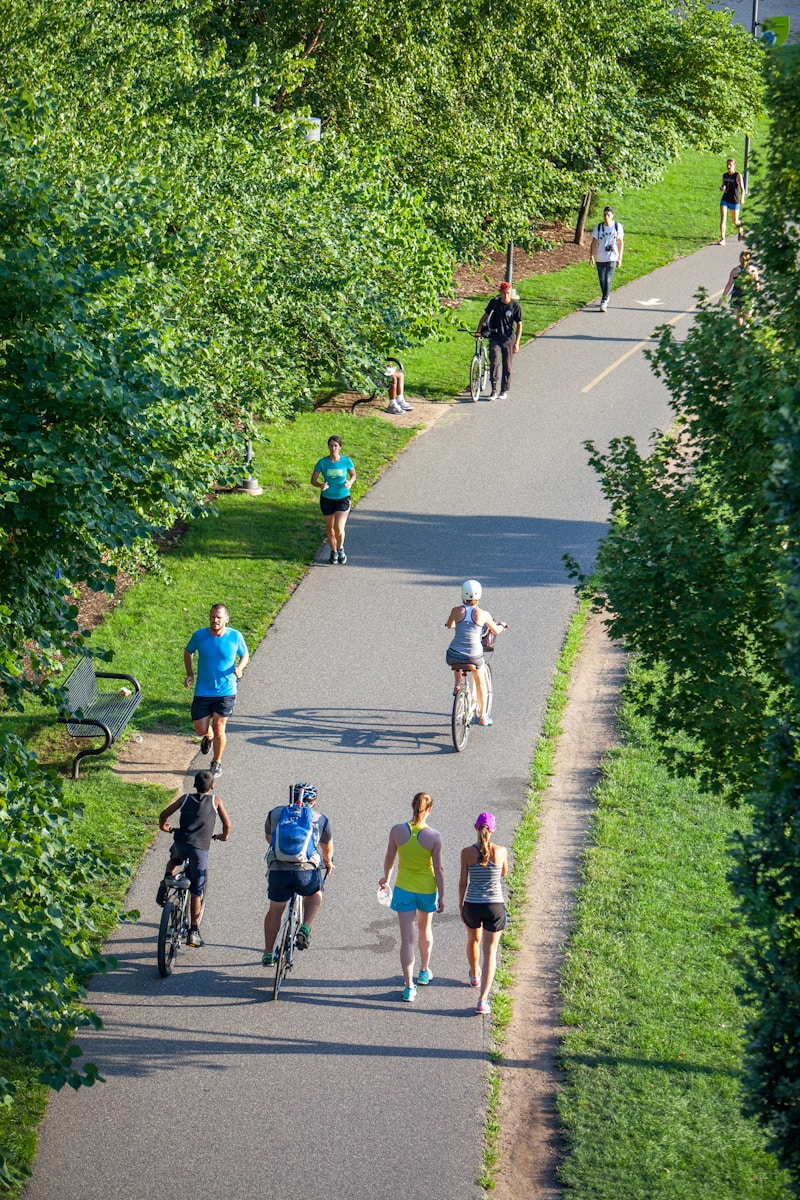The Washington & Old Dominion Railroad Trail stands as Northern Virginia’s cycling crown jewel—a 45-mile paved pathway that has transformed from a defunct railroad into one of the most beloved and heavily-used trails in the United States. As we approach the trail’s 50th anniversary as a public pathway, it’s time to envision how this extraordinary resource can evolve to serve the next generation of cyclists, walkers, and communities along its route.
From Railroad to Recreation: The W&OD’s Remarkable Transformation
The Railroad Era (1859-1968)
The Washington & Old Dominion Railroad began as a dream of connecting the nation’s capital to the agricultural abundance of Virginia’s Piedmont region. Chartered in 1859 as the Alexandria, Loudoun & Hampshire Railroad, the line would eventually stretch 45 miles from Alexandria to Purcellville, with a 32-mile branch to Bluemont.
Historical Milestones:
- 1859: Charter granted for Alexandria, Loudoun & Hampshire Railroad
- 1860s: Construction began, interrupted by Civil War
- 1874: First train reached Leesburg
- 1900: Extension completed to Bluemont, serving resort traffic
- 1911: Reorganized as Washington & Old Dominion Railroad
- 1945: Peak ridership during World War II
- 1968: Final passenger train ran from Alexandria to Purcellville
Economic Development and Community Benefits
Trail-Oriented Development
The W&OD Trail has catalyzed billions in development along its corridor, but this growth must be managed to benefit all communities:
Smart Growth Strategies:
- Transit-oriented development: Encourage affordable housing near trail access points
- Mixed-use zoning: Support walkable, bikeable communities along the trail
- Anti-displacement policies: Protect existing residents from gentrification pressure
- Community benefit agreements: Ensure new development contributes to trail maintenance and community needs
Local Business Support
The trail’s 2+ million annual users represent significant economic opportunity for local businesses:
- Bike-friendly business certification: Program recognizing businesses that welcome cyclists
- Trail-side farmers markets: Regular markets featuring local agricultural products
- Cycling services: Encourage bike shops, repair stations, and rental facilities
- Cultural tourism: Promote the trail as a destination for regional and national visitors
Technology Integration for the 21st Century
Smart Trail Infrastructure
Digital Wayfinding:
- Interactive kiosks: Real-time trail conditions, weather, and event information
- Mobile app integration: Comprehensive trail app with navigation, safety alerts, and community features
- QR code interpretive signs: Instant access to historical information and trail guides
- Emergency alert system: Push notifications for trail closures or safety concerns
Safety Technology:
- Automated traffic signals: Sensors that detect approaching cyclists and pedestrians
- LED lighting systems: Motion-activated, energy-efficient lighting
- Emergency call boxes: Solar-powered emergency communication every half-mile
- Security cameras: Strategic placement at crossings and isolated areas
Data and Analytics
Better data collection will improve trail management and user experience:
- Usage monitoring: Automated counters tracking peak usage times and patterns
- Environmental sensors: Air quality, noise levels, and weather monitoring
- User feedback systems: Easy reporting of maintenance needs and safety concerns
- Performance metrics: Annual reporting on safety, usage, and community impact
Funding the Future: A $200 Million Investment
Comprehensive Funding Strategy
Federal Funding Sources:
- Infrastructure Investment and Jobs Act: $50 million for grade-separated crossings and trail extensions
- Recreation and Public Purposes Act: Land acquisition for trail expansion
- Transportation Alternatives Program: Annual funding for ongoing improvements
- Land and Water Conservation Fund: Acquisition of adjacent parkland
State and Regional Resources:
- Virginia Transportation Investment Program: $75 million over 10 years
- NOVA Parks capital funding: Regional park authority investment
- Smart Scale transportation funding: Priority scoring for trail connectivity projects
- Environmental mitigation funds: Highway projects contributing to trail improvements
Innovative Financing:
- Trail improvement districts: Property owner assessments in high-benefit areas
- Public-private partnerships: Developer contributions for trail enhancements
- Carbon offset programs: Corporate investments in sustainable transportation
- Crowdfunding campaigns: Community-driven funding for specific improvements
Governance and Community Engagement
Regional Coordination
The W&OD Trail crosses multiple jurisdictions, requiring enhanced coordination:
W&OD Trail Authority:
- Unified management: Single entity responsible for trail-wide planning and maintenance
- Stakeholder representation: Including cyclists, pedestrians, adjacent communities, and businesses
- Technical expertise: Professional staff for engineering, environmental management, and community engagement
- Annual planning: Coordinated approach to improvements and programming
Community Input Process
All trail improvements must center community voices:
- Regular town halls: Quarterly meetings in communities along the trail
- Multilingual engagement: Translation and interpretation for non-English speakers
- Youth advisory council: Young people helping shape the trail’s future
- Digital participation: Online surveys and virtual meetings for broader input
Measuring Success: 2030 Goals and Metrics
Safety and Accessibility
- Zero serious injuries: Eliminate life-threatening crashes through design improvements
- Universal accessibility: Full ADA compliance and accommodation for all abilities
- Reduced crime: 50% reduction in reported trail crimes through lighting and security improvements
- Emergency response: Sub-10 minute response times for medical emergencies
Usage and Equity
- Increased ridership: 3 million annual users by 2030
- Demographic diversity: Trail usage reflecting regional demographics
- Transit integration: 40% of trail users arriving by public transportation
- Year-round usage: Consistent usage across all seasons through improved maintenance
Environmental Impact
- Carbon neutrality: Net-zero carbon emissions from trail operations
- Transportation substitution: 5 million car-miles replaced annually by trail usage
- Biodiversity enhancement: Increased wildlife sightings and native plant populations
- Water quality improvement: Measurable improvements in adjacent waterways
Beyond the Trail: Regional Impact
Model for National Trail Development
The enhanced W&OD Trail can serve as a model for trail development nationwide:
- Best practices documentation: Comprehensive guide for other trail managers
- Research partnerships: University collaborations studying trail impacts
- International exchanges: Learning from and sharing with global trail networks
- Policy advocacy: Supporting federal legislation for trail funding and development
Regional Transportation Revolution
An enhanced W&OD Trail contributes to transforming Northern Virginia’s transportation system:
- Reduced traffic congestion: Measurable decrease in peak-hour vehicle trips
- Improved air quality: Contributing to regional emission reduction goals
- Public health benefits: Increased physical activity and reduced healthcare costs
- Economic competitiveness: Enhanced quality of life attracting businesses and workers
A Call to Action: Building the Future Together
The W&OD Trail’s next 50 years depend on actions we take today. This vision requires unprecedented collaboration between government, business, and community organizations. It demands investment not just in infrastructure, but in the idea that public spaces can serve as catalysts for equity, sustainability, and community building.
How You Can Help Shape the Future
Individual Action:
- Use the trail regularly: Demonstrate demand for improvements through consistent usage
- Advocate for funding: Contact elected officials about trail improvement priorities
- Volunteer for maintenance: Join trail clean-up and stewardship activities
- Support local businesses: Patronize trail-adjacent businesses that welcome cyclists and pedestrians
Community Engagement:
- Attend planning meetings: Participate in community input sessions for trail improvements
- Organize neighborhood groups: Coordinate with neighbors to advocate for local improvements
- Share your stories: Document how the trail impacts your life and community
- Welcome newcomers: Help introduce new trail users to safe and enjoyable usage
Professional and Organizational Support:
- Pro bono services: Offer professional expertise for planning and design
- Corporate partnerships: Develop business relationships that support trail improvements
- Grant writing: Help secure funding for priority projects
- Research collaboration: Conduct studies documenting trail benefits and impacts
Conclusion: A Trail for All Generations
The Washington & Old Dominion Trail has already exceeded the wildest dreams of those who envisioned transforming an abandoned railroad into a public pathway. Its success demonstrates what’s possible when communities come together around a shared vision of accessibility, sustainability, and connection.
But the trail’s greatest achievements may still lie ahead. By reimagining the W&OD for the next generation, we can create more than just improved infrastructure—we can build a model of how transportation can serve community goals of equity, environmental sustainability, and economic opportunity.
The railroad that once connected Northern Virginia’s communities to the nation’s capital can now connect those same communities to a more sustainable, equitable future. The question isn’t whether we can afford to make these improvements—it’s whether we can afford not to.
Join us in reimagining the W&OD Trail at our upcoming community visioning sessions, or contact us at wodtrail@cyclingunbound.org to get involved in planning the next 50 years of this remarkable community asset.
Cycling Unbound Foundation is committed to ensuring that the W&OD Trail serves all communities equitably while preserving its historical legacy and environmental value. Together, we can build a trail that reflects our highest aspirations for public space and community connection.




As a daily W&OD commuter for 20 years, this vision gives me hope! The grade-separated crossings can’t come soon enough – especially at Wiehle Avenue and Sunset Hills. One suggestion: consider ‘bike highways’ with express lanes for commuters and separate paths for recreational users during peak hours. The trail’s success is creating congestion that smart design could alleviate.
David, your ‘bike highway’ concept aligns with modern active transportation planning! We’re actually studying a similar approach in Europe where they’ve implemented ‘fast cycling routes’ with wider lanes, banking on curves, and priority signaling. The W&OD could pilot this between Vienna and Reston where commuter traffic is heaviest. The key is maintaining accessibility for all users while improving flow.
Thank you for including universal accessibility in this vision! As someone who uses a handcycle, I’d emphasize the need for wider trail sections at rest areas and water fountains – current pinch points make it difficult to stop safely. Also, please consider adaptive cycle rental stations. The W&OD could become a model for inclusive trail design nationwide.
Fascinating history section! My grandfather was a conductor on the W&OD in the 1940s. While I support modernization, I hope we preserve more of the railroad heritage. The old station foundations, mile markers, and telegraph poles tell important stories. Consider interpretive centers at key locations like Herndon and Leesburg that blend the railroad history with the trail’s future.
Tom, what a wonderful connection to the trail’s history! We absolutely agree about preservation. In fact, we’re advocating for a ‘Rails to Trails Heritage Fund’ that would restore historic structures and create interactive exhibits using QR codes and augmented reality. Imagine pointing your phone at an old station foundation and seeing the 1920s depot come to life! The trail’s future should honor its past.